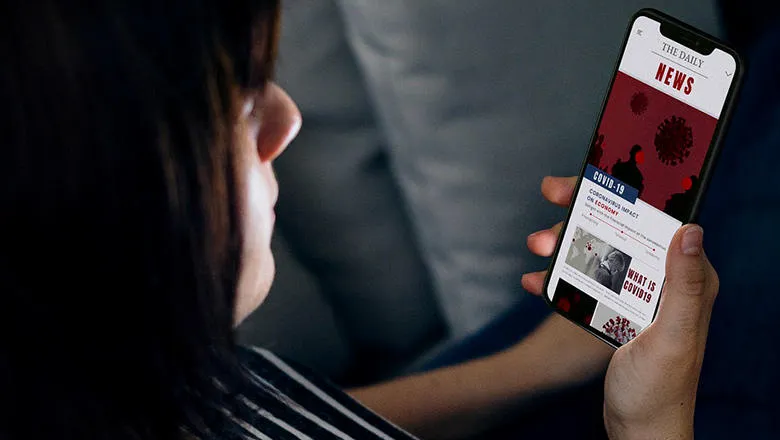Men’s voices dominate in almost every category of media coverage related to the coronavirus crisis and every topic analysed in this study, with the exception of what are often seen as 'women’s issues', such as childcare. The imbalance is worse when it comes to those who are cited in the press as authorities on the pandemic – the more expert and well-known the voices become, the further women’s share in them decreases. While the pandemic continues to have gendered impacts, it is clear that female voices in the public debate are a minority
Laura Jones, Research Associate, Global Institute for Women’s Leadership at King’s College London
30 October 2020
Women have been marginalised in Covid-19 media coverage
Female voices and expertise have been sidelined during the pandemic

Women’s representation and voice in media coverage of the coronavirus crisis
Read the report
Female voices and expertise have been marginalised in media reporting of the coronavirus crisis, a new study has found.
The research, by the Global Institute for Women’s Leadership at King’s College London, is based on an analysis of 146,867 articles related to Covid-19 published between 1 March and 31 July.
The articles were drawn from 15 leading news sources across the UK, Australia and the US and analysed using big-data processing techniques.
Women’s expertise
The study looked at the gender balance of prominent experts mentioned in coverage of two areas with particular relevance to the Covid-19 crisis – science, technology, engineering and mathematics (STEM) and economics.
It found just 5% of well-known STEM experts mentioned were women, meaning that for every mention of a prominent female STEM expert in a news story about coronavirus, there were 19 mentions of their male counterparts.
This poor result was despite the fact that women made up 17% of unique prominent STEM experts mentioned, and is driven by the most frequently named STEM experts – such as Anthony Fauci and Chris Whitty – receiving a very large share of the mentions.
Women also made up 15% of well-known economists named, meaning that for every mention of a prominent female economist there were five mentions of prominent male economists.
The study defined STEM experts and economists as prominent if they were well-known enough to have a Wikipedia entry. By focusing on those with such an online profile, analytical techniques could be used to automatically detect the identities of tens of thousands of individuals mentioned and extract occupational information for them.
Women’s voices
Only a third of those quoted in articles about the pandemic were women, but with significant variation by type of coverage and topic.
37% of quotations in health-related coverage were attributable to women, falling to 27% in business articles, and 24% in science and politics articles.
When looking at coverage of specific topics linked to the coronavirus crisis, there was a clear divide in female voice between traditionally feminine and masculine issues.
Women make up over half of those quoted in articles related to childcare and domestic violence, and more than a third in articles related to education – but fewer than one in six of those quoted in financial and economic coverage.
In articles on two key topics, epidemiology and public health, women made up a quarter of those quoted.
Who’s driving the political debate in the media
For every mention of a female politician in an article about the coronavirus crisis, there were five mentions of a male politician.
Even when references to the (male) national leaders of each country in the sample – Boris Johnson, Donald Trump and Scott Morrison – were excluded, there were still four mentions of a male politician for every mention of a female one.
Technical details
An initial sample of 248,741 articles on the coronavirus pandemic published between 1 March and 31 July 2020 was constructed by pulling every article which mentioned the words “coronavirus” or “Covid-19” from the top five online news outlets (according to global Alexa rankings) in the UK, US and Australia. This was done using the API provided by eventregistry.org, an AI-driven media intelligence platform.
The sources were:
- UK: theguardian.com, bbc.co.uk telegraph.co.uk, independent.co.uk, dailymail.co.uk
- Australia: news.com.au, abc.net.au, smh.com.au, 7news.com.au, sbs.com.au
- US: cnn.com, nytimes.com, cnbc.com, usatoday.com, foxnews.com
After refining the sample to include only articles with a substantial focus on the pandemic, a final sample of 146,867 articles was produced.
News content was sourced from the API provided by eventregistry.org, which also provides information on notable individuals mentioned (those well-known enough to have their own Wikipedia page). This information and the Wikidata Query API was used to generate information on gender and occupation for 54,636 unique individuals, who were mentioned 666,681 times.
Eventregistry.org also classifies articles in categories based on their linguistic content, and provides information on topics discussed in the article. Articles were then weighted depending on the extent to which they focused on a given topic, with only the most relevant articles selected.
To establish the gender of individuals quoted, each article was analysed using the Stanford core NLP java library. This processes sentences into their constituent parts and tags words according to their parts of speech. Every instance where a gendered pronoun was followed by a verb was then extracted and every verb that appeared at least 100 times as indicative of speech (e.g., “he said”, “she argued”) or not (e.g., “he went”) was manually tagged.
See the methodology endnote of the report for further detail.
